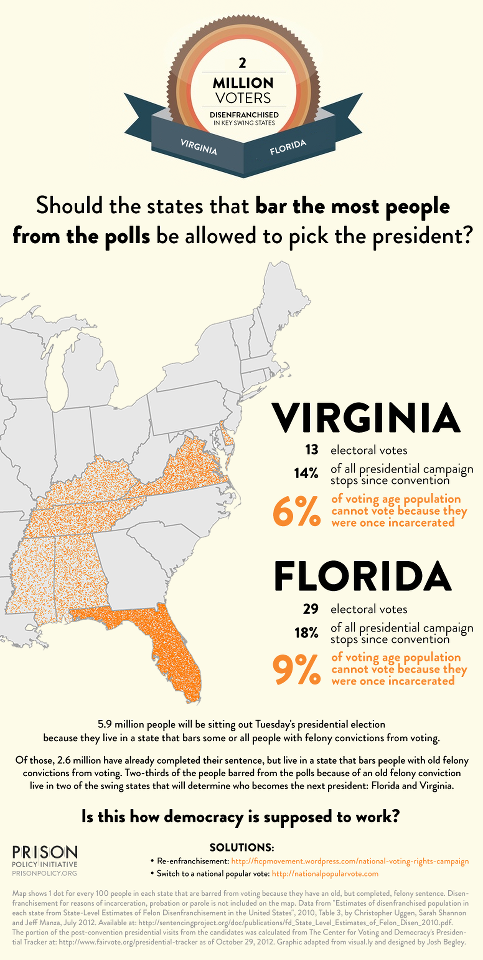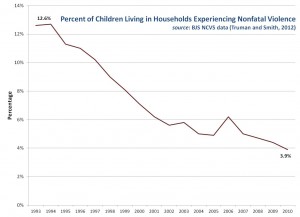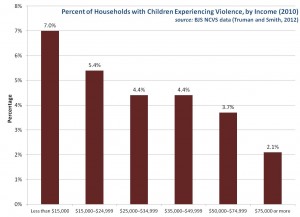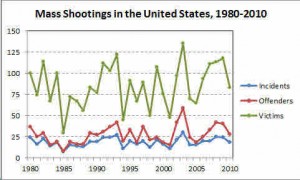Criminologist Charis Kubrin of UC-Irvine went head to head with former Los Angeles District Attorney Steve Cooley yesterday on the issue of prison downsizing in California. In my view, Professor Kubrin’s presentation here is as sharp, clear, and thoughtful as her academic writing. I’ve always found the long-form live interview to be a terrific forum for public criminology, since it leaves a bit more space for academics to introduce social scientific evidence to explain how they arrived at their opinions — and to question those who arrived at opinions based on anecdotal evidence or other means. This one comes from SoCal Insider, a PBS program hosted by Rick Reiff, but similar issues are being debated in many communities. Dr. Kubrin is appropriately cautious about whether crime rates will rise with realignment, but she nicely counters the premature conclusion that California’s experiment in prison downsizing has been a disaster — and she makes an excellent case for conducting a more systematic scientific evaluation.

Though these pages might seem a little quiet lately, rest assured that we’re plugging away on some extra-good crime and punishment features. I’m happily immersed in final edits on some really exciting new pieces for TSP — and our crime volume, due out this fall with WW Norton.
Like what? Look for a moving account of prison and close relationships by Megan Comfort, a social welfare approach to crime control from Rick Rosenfeld and Steve Messner, a roundtable on the International Criminal Court with Susanne Karstedt, Kathryn Sikkink, Naomi Roht-Arriaza, and Wenona Rymond-Richmond, and a powerful piece by pubcrim’s own Michelle Inderbitzin and colleagues on the young leaders of a prison “lifers club,” who will be locked up for decades for crimes committed as juveniles.
In addition to this fine work coming in over the transom, we’ve got a great mix of in-house as well as external (please don’t call them out-house) features forthcoming and under review. I’m helping out on a couple of them, including a soon-to-be-released feature with Sarah Shannon (Visualizing Punishment) and a just-released feature with Suzy Maves McElrath on the big U.S. Crime Drop. More soon!
 Today’s post is coauthored with Jason Schnittker for the Robert Wood Johnson Foundation Human Capital blog.
Today’s post is coauthored with Jason Schnittker for the Robert Wood Johnson Foundation Human Capital blog.
More than 650,000 inmates are released from prison every year.[i] Although their debt to society may be paid, their struggles have just begun. Reentry is not easy. Former inmates need to find a place to live. They need to find a job. And many need to support families. All told, 4 million people in the U.S. are dealing with the “mark” of a prison record and its consequences for their work and personal lives.[ii] Most will struggle for years following their release.
Given all these difficulties, it’s hard to imagine health being a major part of their struggle. After all, many former inmates are still quite young and, for that reason, unlikely to suffer from major health problems. Mental health is part of the picture, but usually considered through a different lens: policy-makers ask how mental illness affects criminal offending—that is, what leads to prison in the first place—but rarely consider the pivotal role of mental health in making a successful return to the community.
Yet the role of mental illness is just as relevant after release as before.[iii]
Insofar as we demand that former inmates become productive and responsible members of society, we may need to provide them with a little more help. Reintegration requires persistence, motivation, and a strong social network, all of which are undermined by mental health problems. Mood and anxiety disorders, in particular, can rob individuals of motivation and initiative and undermine their relationships. Psychosis and substance abuse are, of course, important as well, especially in preventing new offending. But good health is more than the absence of these particular conditions, just as reintegration is more than the absence of particular criminal behaviors. Reintegration also implies successful adjustment to challenging work and family situations — and good overall health fortifies us all in meeting such challenges.
To date, enthusiasm for better mental health treatment among former inmates has been limited. From a cost-benefit perspective, the role of treatment in reducing crime is inconclusive.[v] But evidence on the effectiveness of mental health treatment for other outcomes, including employment, is more favorable.[vi] The Affordable Care Act will help.[vii] A robust safety net of low cost service providers will help too. But true reform requires something more ambitious: the recognition that good health is a precondition to getting back on your feet.
Jason Schnittker, PhD, and Chris Uggen, PhD, both recipients of Robert Wood Johnson Foundation (RWJF) Investigator Awards in Health Policy Research, recently published a study in the Journal of Health and Social Behavior on incarceration and psychiatric disorders. They found that incarceration increases the risk of mood disorders after release and that these disorders increase disability. Schnittker is an associate professor in the Department of Sociology at the University of Pennsylvania. Uggen is the Distinguished McKnight Professor in the Department of Sociology at the University of Minnesota.
I’ve been reluctant to write about the terrible events at Sandy Hook Elementary School because the wounds are still too fresh for any kind of dispassionate analysis. As a social scientist, however, I’m disappointed by the fear-mongering and selective presentations of the research evidence I’ve read in reports and op-eds about Friday’s awful killing.
Such events could help move us toward constructive actions that will result in a safer and more just world — or they could push us toward counter-productive and costly actions that simply respond to the particulars of the last horrific event. I will make the case that a narrow focus on stopping mass shootings is less likely to produce beneficial changes than a broader-based effort to reduce homicide and other violence. We can and should take steps to prevent mass shootings, of course, but these rare and terrible crimes are like rare and terrible diseases — and a strategy to address them is best considered within the context of more common and deadlier threats to population health. Five points:
1. The focus on mass shootings obscures over 99 percent of homicide victims and offenders in the United States. The numbers should not matter to parents who must bury their children, but they are important if policy makers are truly committed to reducing violent deaths. There are typically about 25 mass shootings and 100 victims each year in the United States (and, despite headlines to the contrary, mass shootings have not increased over the past twenty years). These are high numbers by international standards, but they pale relative to the total number of killings – about 14,612 victims and 14,548 offenders in 2011. In recent years, the mass shooters have represented less than two-tenths of 1 percent of the total offenders, while the victims have represented less than one percent of the total homicide victims in any given year. We are understandably moved by the innocence of the Sandy Hook children, but we should also be moved by scores of other victims who are no less innocent. There were 646 murder victims aged 12 or younger in the United States in 2011 alone — far more than all the adults and children that died as a result of mass shootings.
2. The focus on mass shootings leads to unproductive arguments about whether imposing sensible gun controls would have deterred the undeterrable. As gun advocates are quick to point out, many of the perpetrators in mass shootings had no “disqualifying” history of crime or mental disorder that would have prevented them from obtaining weapons. And, the most highly motivated offenders are often able to secure weapons illegally. Even if such actions do little to stop mass shootings, however, implementing common-sense controls such as “turning off the faucet” on high capacity assault weapons, tightening up background checks, and closely monitoring sales at gun shows are prudent public policy. But the vast majority of firearms used in murders are simple handguns. I would expect the no-brainer controls mentioned above to have a modest but meaningful effect, but we will need to go farther to have anything more than an incremental effect on mass shootings and gun violence more generally.
3. The focus on mass shootings obscures the real progress made in reducing the high rates of violence in the United States. I heard one commentator suggest that America had finally “hit bottom” regarding violence. Well, this is true in a sense — we actually hit bottom twenty years ago. The United States remains a violent nation, but we are far less violent today than we were in the early 1990s. Homicide rates have dropped by 60 percent and the percentage of children annually exposed to violence in their households has fallen by 69 percent since 1993. We can and should do better, of course, but these are not the worst of times.
4. The focus on mass shootings exaggerates the relatively modest correlation between mental illness and violence. Those who plan and execute mass shootings may indeed have severe mental health problems, though it is difficult to say much more with certainty or specificity because of the small number of cases in which a shooter survives to be examined. We do know, however, that the correlation between severe mental illness and more common forms of violence is much lower — and that many types of mental health problems are not associated with violence at all.
5. The focus on mass shootings leads to high-security solutions of questionable efficacy. Any parent who has attempted to drop off a kid’s backpack knows that security measures are well in place in many schools. Rates of school crime continue to fall, such that schools are today among the safest places for children to spend so many of their waking hours. In 2008-2009, for example, only 17 of the 1,579 homicides of youth ages 5-18 occurred when students were at school, on the way to school, or at school-associated events. Of course we want to eliminate any possibility of children being hurt or killed at school, but even a 2 percent reduction in child homicide victimization outside of schools would save more lives than a 90 percent reduction in school-associated child homicide victimization. While every school must plan for terrible disasters in hopes that such plans will never be implemented, outsized investments in security personnel and technology are unlikely to serve our schools or our kids.
In the aftermath of so many deaths I am neither so cynical as to suggest that nothing will change nor so idealistic as to suggest that radical reform is imminent. I’m just hoping that the policy moves we make will address our all-too-common horrors as well as the rare and terrible events of the past week.
 When you take a course of antibiotics to zap a bacterial infection, you can also lay waste to a lot of healthy bacteria that your body really needs. And once you’ve wiped out the healthy flora in your gut, you’re vulnerable to nasty bacteria such as Clostridium Difficile, which brings symptoms ranging from severe diarrhea to life-threatening colon problems. Though I’m skeptical-bordering-on-terrified of organicist arguments in sociology, hearing a talk by Minnversity colleague Mike Sadowsky on “C. diff.” brought some parallels in social research to mind. Before proceeding, I should acknowledge the obvious “ick factor” in this post, but bear with me a moment.
When you take a course of antibiotics to zap a bacterial infection, you can also lay waste to a lot of healthy bacteria that your body really needs. And once you’ve wiped out the healthy flora in your gut, you’re vulnerable to nasty bacteria such as Clostridium Difficile, which brings symptoms ranging from severe diarrhea to life-threatening colon problems. Though I’m skeptical-bordering-on-terrified of organicist arguments in sociology, hearing a talk by Minnversity colleague Mike Sadowsky on “C. diff.” brought some parallels in social research to mind. Before proceeding, I should acknowledge the obvious “ick factor” in this post, but bear with me a moment.
As Dr. Sadowsky explained, one successful treatment for recurrent C. diff infections involves fecal transplantation – essentially implanting a donor’s stool sample in a recipient to repopulate the healthy colonic flora and restore bacterial balance. Within a very short time, the donor’s gut flora is typically brought back to healthy equilibrium. Now that might sound icky (even when said sample is freeze-dried), but it is way less icky than surgical treatments like colectomy. What really got me thinking was my colleague’s big-picture conclusion that much of the past century of U.S. research in this area had been devoted to isolating and zapping the bacterial delinquents, while much of the next century seems devoted to restoring the whole to healthy balance. And, if I understand things correctly, it turns out that the latter approach is actually a lot simpler than specifying, modeling, and manipulating the complex interactions among myriad bacteria that may be “good” or “bad” depending on the particular combination and circumstance.
Of course, certain Ghosts of Sociology Past, Present, and Future think about societies in quite similar ways. No, people aren’t bacteria and communities aren’t intestines, but you don’t have to be a functionalist or an organicist to draw some basic analogies. For example, as William Julius Wilson points out, it is the social isolation of the urban poor that exacerbates the challenge of redressing imbalances and (re)building the institutions needed for basic community functioning. More generally, social interventions, like medical interventions, sometimes bring their own pathologies or iatrogenic effects. Like the overprescription of antibiotics behind the apparent C. diff epidemic, the grand American experiment with racialized mass incarceration, has had untold effects on individuals, families, and communities that are only now coming into focus.
I won’t speculate here about how to restore social systems to healthy balance, but some of us try to at least consider such questions in our research. In some cases, this involves calling out the problems associated with attempts to isolate and zap our more delinquent members. In others, it involves identifying and assessing viable alternative approaches to reducing harm — regardless of any potential “ick factors” that might be associated with our research.
Here’s an election image from the smart and creative folks at the Prison Policy Initiative, adapting some data from our recent Sentencing Project report on felon disenfranchisement. 
A new Bureau of Justice Statistics Report by Erica Smith and Jessica Truman shows a significant decline in the Prevalence Of Violent Crime Among Households With Children, 1993-2010. The study is based on the large-scale annual National Crime Victimization Survey (NCVS) and it differs from standard victimization reports in its explicit focus on households with kids.
The chart below shows the percentage of households with children in which at least one member age 12 or older experienced nonfatal violent victimization (rape, sexual assault, robbery, aggravated assault, and simple assault) in the previous year. This does not necessarily mean that the children witnessed the violence or that they were even aware of it, but it does give us a pretty good sense of whether kids are living with household members who are themselves experiencing violence. And the NCVS provides the sort of high-quality nationally representative survey data that are useful in charting big-picture trends. According to the report, this rate dropped from 12.6 percent of children to 3.9 percent in the past 18 years (the blip in 2006 is due to a shift in methodology). That’s an impressive 69 percent decline since 1993.
These numbers still seem high to me, but I think it is because simple assault (which encompasses a pretty broad range of behavior) accounts for the bulk of the violence (about 2.6 percent of the 3.9 percent total in 2010). Which kids are most affected? Children in urban areas, children of color, and lower-income children are most likely to live in households experiencing violent victimization. Rates are significantly higher for urban households with children (4.5 percent) than for rural (3.6 percent) or suburban (3.2 percent) households. With respect to race and ethnicity, rates are lower fir households headed by Asians/Pacific Islanders (1.4 percent) than for households headed by multiracial persons (5.6 percent), American Indians/Alaskan Natives (5.3 percent), African Americans (4.9 percent), Hispanics (4.0 percent), and Whites (3.4 percent) (the authors caution, however, that estimates for several of these groups are based on a small number of cases). There is also a very clear socioeconomic gradient to violent victimization: the greater the household income, the lower the rate of violent victimization, as shown below.
This sort of story might be familiar to criminologists: the overall crime situation is improving, but victimization is heavily concentrated among the most disadvantaged. Nevertheless, this report is important and useful in showing how children’s proximity to violence is changing in some ways — and not changing in others.
 I rarely write about crime fiction, since most of it seems completely orthogonal to the phenomenon that I’ve spent a career studying. Quentin Tarantino, Martin Scorcese, and the Brothers Coen are surely gifted filmmakers, but the hyperviolent worlds they create are pure fantasy — bearing about the same relation to the lived reality of crime as the average pornographic film bears to the lived reality of human sexuality. By confronting compelling characters with horrible moral choices, however, the best crime fiction can actually tell us something meaningful about human frailty, morality, and justice.
I rarely write about crime fiction, since most of it seems completely orthogonal to the phenomenon that I’ve spent a career studying. Quentin Tarantino, Martin Scorcese, and the Brothers Coen are surely gifted filmmakers, but the hyperviolent worlds they create are pure fantasy — bearing about the same relation to the lived reality of crime as the average pornographic film bears to the lived reality of human sexuality. By confronting compelling characters with horrible moral choices, however, the best crime fiction can actually tell us something meaningful about human frailty, morality, and justice.
I think Breaking Bad succeeds on this level, though I still switch over to the Hallmark channel or America’s Cutest Pets during its ugliest moments. I have many questions about the show, but Joe Kleinschmidt’s Minnesota Daily article answered one of the biggies. Forget about the crime, how’s the chemistry? Mr. Kleinschmidt put the question to Bill Tolman, the straight-up brilliant Minnesota chemistry professor and department chair pictured above. I was surprised to learn that the show’s etch-a-sketch explosive might’ve actually worked and that the makeshift battery that Walter White constructs in the desert might indeed have started his stranded mobile meth lab:
Walt uses the RV’s brake pad for its mercuric oxide and graphite. This serves as the cathode, which gains electrons. He also gathers spare metallic parts, nuts and bolts, for the zinc they contain. The zinc serves as the anode, where the other electrochemical half-reaction occurs (loss of electrons). With potassium hydroxide solution leftover from their meth-making process serving as electrolyte (to conduct charge), Walt uses a sponge to separate the anode and cathode. Finally, he connects the cell components with copper wire and connects the parallel batteries to the RV’s jumper cables. “The only question now is, will this supply enough current?” Walt says in the episode, posing the only hang-up in his plan. “When he said that, I thought, ‘Yes! That’s the problem!’” Tolman said. But it worked. As Walt sets the batteries up and connects the wires, he creates a spark and the RV is revived. “It was a perfectly reasonable electrochemical cell using mercuric oxide and zinc,” Tolman said.
Of course, the show takes a few liberties — hastening a body’s dissolution in hydrofluoric acid, for example, and tossing around mercury fulminate like a bag of powdered sugar. All told, however, Breaking Bad does pretty well on the chemistry. As for its portrayal of drug markets, I’d have a few more quibbles…
Over on facebook, my friends Raka and Jay asked similar questions about the long-term drop in violence discussed in the previous post.
“They asked, and you answered, about “violence” But what they seem to be thinking about is mass killings by individuals. Are those also on the decline in the US? Who has data on that?”
and
“I’d be interested in knowing the rise and fall rates of different kinds of crimes — one on one homicide versus the movie theater/Sikh temple sort. Michael Hout? Chris Uggen?”
Fortunately, criminologist James Alan Fox has conducted precisely this sort of analysis. His chart below shows the annual number of mass shootings, offenders, and victims in each year from 1980 to 2010.
Professor Fox describes how mass shootings remain quite rare in the U.S. (about 20 incidents and 100 victims per year) relative to other homicides (about 15,000 victims per year), as illustrated in the figure above. Since 1980, I see variation, but no strong upward or downward trend — a non-pattern that we sometimes call “trendless fluctuation,” at least until we can identify its correlates (e.g., a pattern that looks like this).
This is important to bear in mind, as Dr. Fox points out, before (a) we assume there’s been a big increase in mass shootings; and, (b) we attribute this rise to factors that appear to be steadily increasing or declining, such as weapons technology or the availability of mental health care. I’ve no doubt that weapons and mental health care play a big role in such cases, but it is hard to see how either factor could explain the pattern shown above — that is, to predict something that goes up and down with something that just goes up or just goes down over the same period.
The only points I’d add to Professor Fox’s careful analysis is to note that when the numbers are this small the picture could change very quickly. First, it might change if one examined different thresholds or constructed other definitions of mass killings. Second, the chart would look radically different if, heaven forbid, there are more events in the next year or two that push the total number of victims past 150. So, it is probably best to be cautious before making any predictions about the future. All that said, however, it doesn’t appear that we’re currently in the midst of a steep rise in mass killings.
I’m often hesitant to do interviews in the immediate aftermath of a horrific crime, but I was glad when WCCO-TV asked “Are we more violent than ever before?” as part of their Good Question series. Jason DeRusha (and his colleague Liz Collin) do a terrific job with this feature, interviewing diverse experts on questions ranging from dandelions and tick spray to ammunition purchases and solitary confinement.
Since one can’t really provide a reading list on-air, I’ll offer a few supporting citations for those interested in trends in violence and homicide. On long-term historical trends, Steven Pinker’s Better Angels of our Nature is an accessible starting point. In my research and teaching, I’ve been most influenced by Manuel Eisner’s work, particularly his 2003 review in Crime and Justice. For more recent years, good data are widely available, especially for homicide. For the United States, I go directly to the FBI’s Uniform Crime Reports and the Bureau of Justice Statistics’ Criminal Victimization series.



